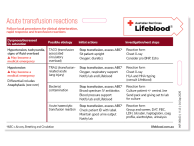Don’t have an account?
Select the donation type you’d like to make
Good documentation of transfusions allows easy and accurate review of records when required for:
- investigating a transfusion-related adverse event
- facilitating donor and recipient ‘look back’ exercises
- quality improvement audits
- management of legal risk
Recommended procedure for documentation
The prescribing doctor should document the transfusion decision rationale in the medical notes.
- Base your transfusion decision on recognised clinical practice guidelines.
- Detail the outcome of the informed consent process.
- Inform your patient of the potential benefits and risks of transfusion in their particular case and their right to receive or refuse it. Record this decision.
The prescription for blood components and fractionated plasma products is the responsibility of a doctor.
- Document the prescription and specify blood component or fractionated plasma product to be administered, the quantity, the duration of transfusion and any special requirements.
A permanent record of the transfusion episode should be kept in the medical notes, including the following:
- The blood transfusion record which includes:
- date and time the transfusion commenced and completed
- type of blood component used and number of units transfused
- donation or batch number
- signature of person administering the transfusion, and
- signature of person confirming the identity of the patient.
- The sheets used for the prescription of blood components or fractionated products
- Nursing observations during the transfusion
- Whether or not the transfusion achieved the anticipated benefit
- Management of any adverse events.
All records must be held for the required legislated period.
We recommend for you to set a laboratory or hospital policy based on the highest standards that you use for the storage of medical records within your facility. This requirement varies between States and territories.
Documentation of inventory
In addition to transfusion records, you must also keep an inventory record of products received and what happens to them.
We suggest that you maintain an inventory register to record receipts of components or products, and what their fate is.
Data collected should include:
- product
- unique or batch number
- blood group (if applicable)
- expiry date
- date received
- fate of item (transfused with patient’s name, wasted with reason, sent to where, etc.), and
- date fate applied
Traceability and Lifeblood
There is a requirement that all blood donations can be traced from the donor to the final fate of the blood component or fractionated product.
This means that, no matter how many products and components we make from a donation, all products are traceable to its fate, even if the fate is that it is destroyed unused.
There are situations when donors, who were well when they donated, subsequently let us know that they have developed symptoms of a disease state. Usually this is not a problem but certain diseases can be of concern. We locate the fate of potentially harmful units. If they have not been transfused, we quarantine them so they are not transfused pending further testing and or investigation.
If they have been transfused, it may be necessary to trace the recipients of the donations and offer them medical advice. We can only achieve this through the availability of well-maintained records showing receipt and fate of blood components or fractionated products.




